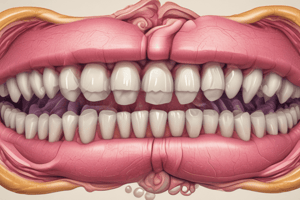Podcast
Questions and Answers
What is the primary function of salivary amylase in the initial stages of carbohydrate digestion?
What is the primary function of salivary amylase in the initial stages of carbohydrate digestion?
Salivary amylase breaks down complex carbohydrates into disaccharides and trisaccharides.
How does the pH level in the stomach affect the activity of salivary amylase?
How does the pH level in the stomach affect the activity of salivary amylase?
Salivary amylase is deactivated when the pH in the stomach falls below 4.5.
What stimulates the release of buffers into the duodenum, and what effect do these buffers have on the pH?
What stimulates the release of buffers into the duodenum, and what effect do these buffers have on the pH?
Secretin stimulates the release of buffers, which shift the duodenal pH from acidic to alkaline.
What is the role of cholecystokinin (CCK) in carbohydrate digestion?
What is the role of cholecystokinin (CCK) in carbohydrate digestion?
How does pancreatic alpha-amylase compare to salivary amylase in terms of function, and where does it exert its effect?
How does pancreatic alpha-amylase compare to salivary amylase in terms of function, and where does it exert its effect?
What triggers the release of gastric inhibitory peptide (GIP), and what is its effect on the pancreas?
What triggers the release of gastric inhibitory peptide (GIP), and what is its effect on the pancreas?
Name three enzymes found in the brush border of the epithelial cells lining the jejunum, and specify the disaccharides they break down.
Name three enzymes found in the brush border of the epithelial cells lining the jejunum, and specify the disaccharides they break down.
Describe the process by which monosaccharides, produced from carbohydrate digestion in the jejunum, reach the interstitial fluid.
Describe the process by which monosaccharides, produced from carbohydrate digestion in the jejunum, reach the interstitial fluid.
Where do the monosaccharides go after they enter the interstitial fluid, and via what vessel do they travel to reach the liver?
Where do the monosaccharides go after they enter the interstitial fluid, and via what vessel do they travel to reach the liver?
Explain what happens to indigestible carbohydrates, such as cellulose, as they pass through the digestive system.
Explain what happens to indigestible carbohydrates, such as cellulose, as they pass through the digestive system.
How do bacteria in the colon benefit from indigestible carbohydrates, and what byproduct of their metabolism is produced?
How do bacteria in the colon benefit from indigestible carbohydrates, and what byproduct of their metabolism is produced?
Why do foods containing large amounts of indigestible carbohydrates, such as beans, often lead to increased flatulence?
Why do foods containing large amounts of indigestible carbohydrates, such as beans, often lead to increased flatulence?
Identify the enzyme responsible for initiating carbohydrate digestion in the mouth and specify the type of carbohydrate it targets.
Identify the enzyme responsible for initiating carbohydrate digestion in the mouth and specify the type of carbohydrate it targets.
Describe how the body ensures that carbohydrate digestion continues effectively once the acidic chyme enters the duodenum from the stomach.
Describe how the body ensures that carbohydrate digestion continues effectively once the acidic chyme enters the duodenum from the stomach.
Explain why individuals who are lactose intolerant may experience discomfort after consuming dairy products.
Explain why individuals who are lactose intolerant may experience discomfort after consuming dairy products.
Outline the significance of the hepatic portal vein in carbohydrate metabolism following the absorption of monosaccharides in the small intestine.
Outline the significance of the hepatic portal vein in carbohydrate metabolism following the absorption of monosaccharides in the small intestine.
Explain the process of facilitated diffusion in the context of monosaccharide absorption by the epithelial cells of the jejunum.
Explain the process of facilitated diffusion in the context of monosaccharide absorption by the epithelial cells of the jejunum.
Contrast the environments in which salivary amylase and pancreatic alpha-amylase function optimally within the digestive system.
Contrast the environments in which salivary amylase and pancreatic alpha-amylase function optimally within the digestive system.
How does the release of insulin, stimulated by GIP, contribute to the regulation of carbohydrate metabolism?
How does the release of insulin, stimulated by GIP, contribute to the regulation of carbohydrate metabolism?
Describe the sequence of events that occur from the arrival of chyme in the duodenum to the absorption of monosaccharides into the bloodstream.
Describe the sequence of events that occur from the arrival of chyme in the duodenum to the absorption of monosaccharides into the bloodstream.
Outline the roles of both the pancreas and the intestinal lining in the complete digestion of carbohydrates.
Outline the roles of both the pancreas and the intestinal lining in the complete digestion of carbohydrates.
What is the fate of undigested carbohydrates, such as cellulose, in the large intestine, and how does this process affect the gut environment?
What is the fate of undigested carbohydrates, such as cellulose, in the large intestine, and how does this process affect the gut environment?
Contrast the mechanisms by which monosaccharides and disaccharides are processed in the small intestine.
Contrast the mechanisms by which monosaccharides and disaccharides are processed in the small intestine.
Discuss how the body compensates for the inactivation of salivary amylase in the stomach to ensure continuous carbohydrate digestion.
Discuss how the body compensates for the inactivation of salivary amylase in the stomach to ensure continuous carbohydrate digestion.
Explain how the release of GIP links carbohydrate digestion to the regulation of blood glucose levels.
Explain how the release of GIP links carbohydrate digestion to the regulation of blood glucose levels.
Describe the role of the brush border enzymes in the jejunum in terms of their specificity and their location.
Describe the role of the brush border enzymes in the jejunum in terms of their specificity and their location.
How does the structure of the intestinal villi enhance the efficiency of monosaccharide absorption into the capillaries?
How does the structure of the intestinal villi enhance the efficiency of monosaccharide absorption into the capillaries?
Contrast the impact of consuming simple sugars versus complex carbohydrates on the immediate insulin response.
Contrast the impact of consuming simple sugars versus complex carbohydrates on the immediate insulin response.
Explain why cellulose, despite being a carbohydrate, is not a significant source of energy for humans.
Explain why cellulose, despite being a carbohydrate, is not a significant source of energy for humans.
Identify the two primary hormones that coordinate carbohydrate digestion and glucose regulation upon the arrival of chyme in the duodenum, and outline their respective roles.
Identify the two primary hormones that coordinate carbohydrate digestion and glucose regulation upon the arrival of chyme in the duodenum, and outline their respective roles.
Discuss the advantage of having both salivary and pancreatic amylase in the digestive system.
Discuss the advantage of having both salivary and pancreatic amylase in the digestive system.
How do the enzymes maltase, sucrase, and lactase contribute to the process of carbohydrate digestion?
How do the enzymes maltase, sucrase, and lactase contribute to the process of carbohydrate digestion?
Explain why individuals with lactose intolerance may experience gastrointestinal discomfort after consuming dairy products, even though dairy products contain valuable nutrients.
Explain why individuals with lactose intolerance may experience gastrointestinal discomfort after consuming dairy products, even though dairy products contain valuable nutrients.
Describe the role of the hepatic portal vein in directing the flow of carbohydrate digestion products, and discuss its significance in regulating blood glucose levels.
Describe the role of the hepatic portal vein in directing the flow of carbohydrate digestion products, and discuss its significance in regulating blood glucose levels.
Contrast how soluble and insoluble fibers affect the digestive process, particularly in relation to carbohydrate digestion.
Contrast how soluble and insoluble fibers affect the digestive process, particularly in relation to carbohydrate digestion.
Explain the benefits and drawbacks of carbohydrate fermentation by bacteria in the colon.
Explain the benefits and drawbacks of carbohydrate fermentation by bacteria in the colon.
How does the body adapt to variations in carbohydrate intake, such as during periods of high vs. low carbohydrate consumption?
How does the body adapt to variations in carbohydrate intake, such as during periods of high vs. low carbohydrate consumption?
Discuss the potential consequences of a diet consistently high in simple sugars on long-term metabolic health.
Discuss the potential consequences of a diet consistently high in simple sugars on long-term metabolic health.
Explain how understanding the process of carbohydrate digestion can inform dietary choices for individuals with diabetes.
Explain how understanding the process of carbohydrate digestion can inform dietary choices for individuals with diabetes.
Flashcards
Salivary Amylase
Salivary Amylase
An enzyme in saliva that breaks down complex carbohydrates into disaccharides and trisaccharides.
Secretin
Secretin
Hormone that stimulates the release of buffers in the duodenum, shifting pH from acidic to alkaline.
Cholecystokinin (CCK)
Cholecystokinin (CCK)
Hormone that triggers the secretion of pancreatic buffers and enzymes.
Pancreatic Alpha-Amylase
Pancreatic Alpha-Amylase
Signup and view all the flashcards
Gastric Inhibitory Peptide (GIP)
Gastric Inhibitory Peptide (GIP)
Signup and view all the flashcards
Maltase, Sucrase, and Lactase
Maltase, Sucrase, and Lactase
Signup and view all the flashcards
Flatus
Flatus
Signup and view all the flashcards
Study Notes
- Chewing in the mouth mixes food with salivary gland secretions.
- Salivary amylase breaks down complex carbohydrates into disaccharides and trisaccharides.
- Salivary amylase continues to digest carbohydrates until the stomach's pH drops below 4.5, remaining active for 1–2 hours post-meal.
Duodenum
- The arrival of chyme in the duodenum prompts secretin to release buffers.
- Buffers shift the duodenal pH from acidic to alkaline, essential for intestinal enzyme function.
- Cholecystokinin (CCK) triggers the release of pancreatic buffers and enzymes, including pancreatic alpha-amylase.
- Pancreatic alpha-amylase mirrors the function of salivary amylase, which was deactivated in the stomach.
Carbohydrates
- The arrival of chyme, rich in carbohydrates, stimulates gastric inhibitory peptide (GIP) release.
- GIP stimulates insulin release by the pancreas.
Jejunum
- Epithelial cells in the jejunum complete carbohydrate digestion.
- The brush border's plasma membrane contains maltase, sucrase, and lactase.
- Maltase breaks down maltose (glucose + glucose).
- Sucrase breaks down sucrose (glucose + fructose).
- Lactase breaks down lactose (glucose + galactose) into simple sugars for absorption.
- These enzymes transport monosaccharides across the plasma membrane.
- Monosaccharides diffuse through the cytosol and reach the interstitial fluid via facilitated diffusion across the basolateral surfaces.
- Monosaccharides diffuse into the capillaries of the intestinal villi, then transported to the liver via the hepatic portal vein.
Colon
- Indigestible carbohydrates, such as cellulose, remain unaltered by intestinal enzymes and arrive in the colon intact.
- These carbohydrates serve as a nutrient source for colonic bacteria.
- Bacterial metabolic activity produces small amounts of flatus, or intestinal gas.
- Foods high in indigestible carbohydrates, like beans, increase bacterial gas production.
- Increased gas production leads to colon distension, cramps, and more frequent discharge of intestinal gases.
Studying That Suits You
Use AI to generate personalized quizzes and flashcards to suit your learning preferences.




